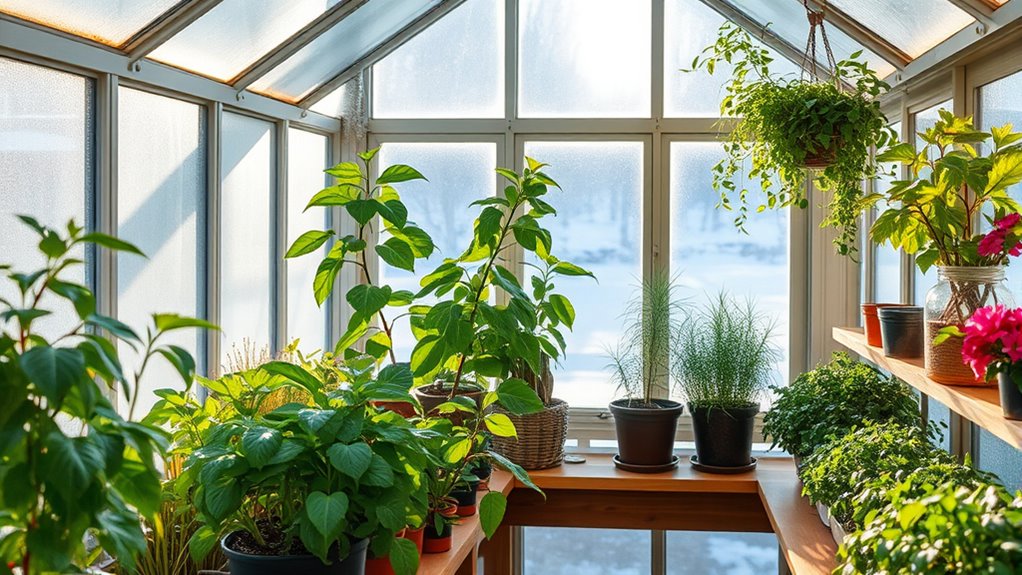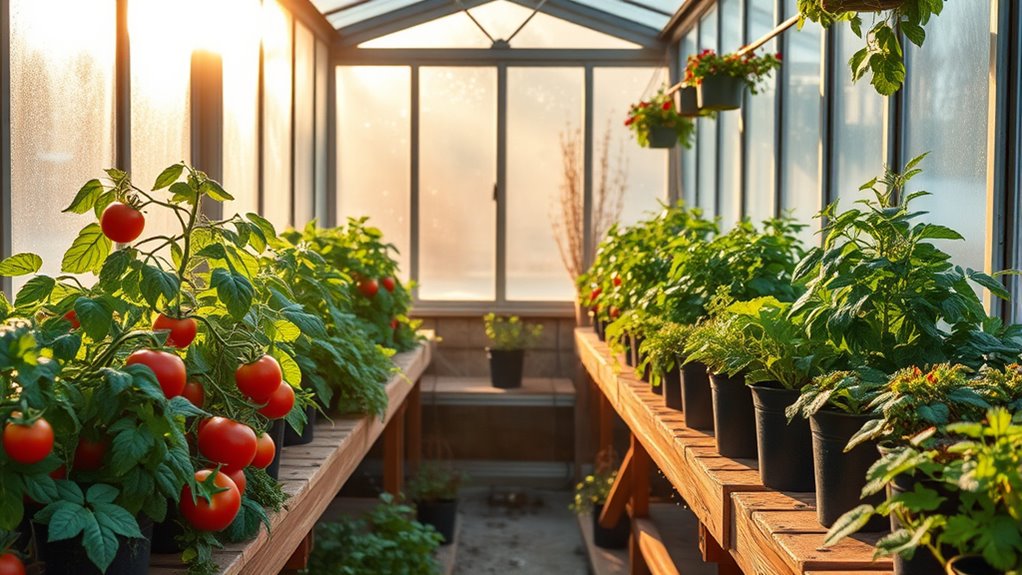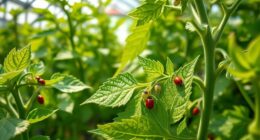Winter greenhouse gardening lets you extend your growing season and enjoy fresh produce even in cold months. By managing temperatures with supplemental heating and insulation, and guaranteeing ample lighting with grow lights, you can keep your plants thriving. Choosing cold-tolerant crops like kale, spinach, and herbs helps ensure success. Regular watering and humidity control prevent disease, while strategic planning maximizes space and resources. Continue exploring for detailed tips on creating a thriving winter greenhouse environment.
Key Takeaways
- Use supplemental heating and insulation to maintain stable, warm temperatures inside the greenhouse during cold months.
- Select cold-tolerant crops like kale, spinach, and herbs, and stagger planting for continuous harvests.
- Supplement natural light with grow lights to ensure 12-16 hours of adequate illumination daily.
- Regularly monitor and manage soil moisture and humidity to prevent diseases and promote healthy growth.
- Plan ahead for seasonal climate changes to optimize environment controls and maximize winter crop productivity.

As winter approaches and outdoor gardening slows down, many gardeners turn to winter greenhouse gardening to keep their green thumbs active. This method allows you to extend your growing season and enjoy fresh produce even during the coldest months. To succeed, you’ll need to focus on effective seasonal crop planning, selecting plants that thrive in cooler temperatures, and managing your greenhouse environment carefully. Planning ahead guarantees you maximize your space and resources, making winter greenhouse gardening both rewarding and efficient.
When you start planning your winter crops, consider plants known for tolerating low temperatures, such as kale, spinach, Swiss chard, and certain herbs like parsley and cilantro. These crops can often be grown successfully in a greenhouse with some basic adjustments. As part of your seasonal crop planning, think about staggered planting schedules. This way, you can harvest continuously rather than all at once, guaranteeing a steady supply of fresh greens and herbs throughout the season.
Controlling the temperature inside your greenhouse is essential. Even in winter, the sun’s rays can warm the space during the day, but nights often bring cold temperatures that can harm delicate plants. Use supplemental heating options like space heaters, and make sure to insulate the greenhouse to retain warmth. Proper ventilation is equally important; it prevents excess humidity and reduces the risk of fungal diseases, which can be more prevalent in winter conditions. Additionally, understanding the seasonal climate helps you better prepare your greenhouse for fluctuations in temperature and humidity levels.
Maintaining temperature and ventilation is key to healthy winter greenhouse crops.
Lighting plays an important role in winter greenhouse gardening. Shorter days mean less natural sunlight, so supplementing with grow lights can keep your plants healthy and productive. Position the lights close enough to provide adequate energy without causing heat stress. Be mindful of the light schedule; most winter crops need around 12-16 hours of light daily to flourish.
Watering also requires attention. The cooler air and soil can cause watering to become more delicate; overwatering can lead to root rot, while underwatering stunts growth. Use a soil moisture meter or check the soil regularly to maintain consistent moisture levels. Additionally, because humidity can fluctuate, ensure proper airflow to reduce mold and mildew issues.
Frequently Asked Questions
How Do I Prevent Frost From Damaging Plants Inside the Greenhouse?
To prevent frost damage, you should focus on plant insulation and choosing frost resistant varieties. Insulate your greenhouse with bubble wrap or thermal curtains to keep warmth in. Grow frost resistant varieties that tolerate cold temperatures better. Additionally, monitor the weather forecast and use heaters or heat mats during cold snaps. Proper ventilation and covering sensitive plants overnight also help protect them from frost, ensuring your plants thrive despite the cold.
What Are the Best Low-Maintenance Crops for Winter Greenhouse Gardening?
Think of your winter greenhouse like a cozy fortress; the best low-maintenance crops are hardy, resilient plants. For example, kale and spinach thrive with minimal fuss. Use companion planting to boost growth and soil amendments to enrich nutrients. These strategies create a self-sustaining system, making winter gardening easier. You’ll enjoy fresh greens all season without constant attention—your greenhouse becomes a reliable winter oasis.
How Can I Optimize Natural Light During Shorter Winter Days?
To optimize natural light during shorter winter days, focus on maximizing light reflection inside your greenhouse and proper window positioning. Position your windows where they can capture the most sunlight, ideally south-facing. Use reflective surfaces like white paint or foil on walls to bounce light around, ensuring your plants receive ample illumination. This boosts growth and helps your winter crops thrive despite limited daylight.
What Heating Options Are Most Energy-Efficient for Winter Greenhouses?
Did you know that passive solar heating can cut your energy use by up to 50%? For your greenhouse, consider using thermal curtains at night to retain warmth, while maximizing passive solar gains during the day. These options are energy-efficient and cost-effective, helping you maintain a stable temperature without high electricity bills. Combining thermal curtains with strategic placement for passive solar can keep your plants warm all winter long.
How Do I Manage Humidity Levels to Prevent Mold and Pests?
To manage humidity levels and prevent mold and pests, you should focus on humidity control in your greenhouse. Ventilate regularly to reduce excess moisture, and use dehumidifiers if needed. Keep air circulation steady and avoid overwatering your plants. Proper humidity control helps with mold prevention and keeps pests at bay, creating a healthier environment for your winter crops. Regularly monitor humidity levels to maintain ideal conditions.
Conclusion
As you step into your winter greenhouse, you become a beacon of life amid the icy silence. With each sprout and blossom, you prove that even in the coldest months, your garden is a warm haven of growth and hope. Embrace the challenge, and let your green thumb be the sun that melts winter’s chill. Your garden isn’t just surviving—it’s thriving, a vibrant symphony breaking through winter’s icy silence.









